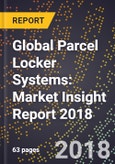This report complements The author's Global Parcel Shops and Locker Networks: Market Insight Report 2018.
The report explores the market for the sale of parcel locker systems as capital equipment, used by carriers and other parties to operate locker networks.
It provides estimates of the total installed base of lockers, typical locker pricing, the market value and our view of the potential for further deployments.
Key drivers are analysed, such as internet retail trends in key countries and globally
The report also profiles leading parcel locker suppliers, providing insight on their products, business models, operations, positioning and key customers.
The main sources for the report are
- Extensive desk research on the parcel lockers market and its operators covering company accounts, websites and other sources
- Published information on key market drivers such as economic data and estimates of home shopping levels and practices
- Interviews with senior-level contacts in the market
- The author’s experience in parcel lockers from having advised locker start-ups, investors in the area and, most recently, the Government of Singapore on its intended parcel locker deployment in the territory
Definition
- Parcel lockers are secure locker banks, which typically consist of 20-100+ electronic lockers and a control unit which allows each compartment to be opened by someone with the necessary access credentials.
- This is often done via a PIN code sent to a customer by email or SMS following a booking transaction carried out on a website and/or a smart card provided to registered users.
- Lockers are generally installed in locations which have both long access hours and a reasonable degree of security, such as railway stations, shopping centres, leisure centres, supermarket car parks and petrol station forecourts.
- Parcel locker banks typically have a data link – usually in real-time – to update the system of the network operator or parcel carrier when an event, such as a delivery or collection, has occurred. The data link may be either fixed line or mobile. This means that the operator is able to track usage, know which lockers are empty or full and hence, where there is spare capacity in the network.
- A typical parcel locker bank will have a central control module, containing a computer, screen and input keyboard. Most parcel lockers are now modular, meaning that locker banks can be a variety of sizes, with a variety of sizes of locker compartments within it.
Why is it important?
- Parcel locker networks are rapidly being rolled out across the globe. They are becoming an essential component of the logistics operations involved in getting internet purchases into the hands of consumers.
- Parcel lockers are also a method of keeping delivery costs down, as parcels are always ‘delivered first time’ to a locker. Those companies building networks frequently advocate lockers as one of the best solutions for long-standing problems such as the last mile and returns.
- Locker networks offer potential benefits for all stakeholders, from retailers to transport companies, consumers and also the environment – by reducing the number of delivery vans on the road.
- Across the logistics industry they are one of the fastest growing areas and appear likely to remain so in the future.
Competitive Landscape
This report profiles the leading global parcels locker suppliers including the following:
- KEBA
- Integer.pl
- TZ
- SNBC
- SmarteCarte
- SwipBox
- Azkoyen
- Cleveron
- ByBox (Logibag)
- Kern
- Zhilai
- Vlocker
Key market insights
The last mile element of parcel delivery is the most expensive stage, typically accounting for 35-50% of total costs. Parcel lockers offer a convenient last-mile delivery solution for consumers, retailers and parcel carriers which has the potential to reduce overall costs significantly by transforming a series of fragmented home deliveries into a single consolidated drop and pick-up at one location. Parcel locker networks can be used as:
- The primary delivery destination in a click-and-collect model
- Back-up in the case of a failed delivery, giving the consumer a more convenient option than the traditional card through the letter box which requires a journey to a depot, often situated in a distant industrial zone, to collect a parcel
- A convenient and low-cost returns method
- A way for consumers to send parcels
Some parcel locker manufacturers also operate their own locker networks.
For carriers, the use of locker networks offers large operational cost savings. In particular, the networks significantly reduce carrier costs by transforming a series of fragmented home deliveries into a single consolidated drop and pick-up at one location.
- The pioneer in the use of parcel lockers for B2C applications was Deutsche Post via its Packstation network which now has 2,750 locations in Germany.
- Many other European countries have locker networks and they are now gaining traction in the US. Leading online retailer, Amazon, is building its own networks in the US, UK and elsewhere.
- Parcel locker installations in China have grown rapidly over the last three to four years, with many thousands of lockers being installed.
Parcel locker technology has continued to evolve.
- Terminals are modular, meaning that they can be configured to fit space and volume requirements
- Some manufacturers offer smaller footprint locker units for sites where volumes are modest and space might be tight.
- Lockers require data and electrical connections, either via an ethernet or a mobile phone network.
- Video cameras are widely used to record who uses the control unit.
- One of the most important areas of innovation is in payment systems. This is particularly relevant for markets, such as China, where there is a high proportion of cash-on-delivery shipments.
Table of Contents
Companies Mentioned (Partial List)
A selection of companies mentioned in this report includes, but is not limited to:
- Azkoyen
- ByBox (Logibag)
- Cleveron
- Integer.pl
- KEBA
- Kern
- SmarteCarte
- SNBC
- SwipBox
- TZ
- Vlocker
- Zhilai








